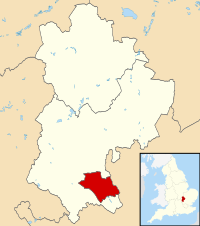
Back Luton AN لوتن Arabic لوتن ARZ Luton AST Luton Azerbaijani لوتون AZB Лутон Bashkir Лутан Byelorussian Лутан BE-X-OLD Лутън Bulgarian
Luton (/ˈluːtən/ ⓘ)[7] is a town and unitary authority with borough status in Bedfordshire, England, with a population at the 2021 census of 225,262.[5][8]
Luton is on the River Lea, 32 miles (50 km) north-west of London,[9] 18 miles (29 km) north-west of Hertford, 20 miles (32 km) south of Bedford[9] and 23 miles (37 km) south-east of Milton Keynes. The town's foundation dates to the sixth century as a Saxon settlement on the river, from which Luton derives its name.[10] Luton is recorded in the Domesday Book as Loitone and Lintone.[11] One of the largest churches in Bedfordshire, St Mary's Church, was built in the 12th century.[12] There are local museums which explore Luton's history in Wardown Park[13] and Stockwood Park.[14]
Luton was once known for hatmaking and also had a large Vauxhall Motors factory. Car production at the plant began in 1905 and continued until its closure in 2002.[15] Production of commercial vehicles continues and the head office of Vauxhall Motors is in the village of Chalton on the northern border of the borough .[16] London Luton Airport opened in 1938 and is now one of Britain's major airports,[17] with three railway stations also in the town. The University of Bedfordshire was created from a merger with the University of Luton;[18] two of its campuses are in Luton.[19]
Luton Town Football Club, nicknamed the Hatters, due to the town's connection to hatmaking, has had several spells in the top flight of the English league as well as a Football League Cup triumph in 1988. They play at Kenilworth Road, their home since 1905; planning permission for a new larger stadium was approved in 2019.[20] Luton International Carnival, the largest one-day carnival in Europe, is held on the day before the last Monday in May;[21][n 1] the Saint Patrick's festival is held on the weekend nearest to Saint Patrick's Day[22] as there is a large Irish community in Luton. The town also has a large Pakistani community which, along with the Irish, were attracted to employment at the Vauxhall car plant.[23][24] Luton Hoo is an English country house, estate and Grade I listed building originally designed by Scottish architect Robert Adam but later transformed to the designs of Robert Smirke.[25]
- ^ Relief of Luton's coat of arms and motto on the gate of Wardown Park
- ^ Cite error: The named reference
coatofarmswas invoked but never defined (see the help page). - ^ Luton: Straw Hat Boom Town (PDF). Luton Cultural Services Trust. 2011. p. 9. Archived from the original (PDF) on 15 October 2013. Retrieved 25 April 2019.
The aspiration contained in its motto: Scientiae et labori detur (May it be given to skill and industry)
- ^ Leadership=Mayor & Cabinet
- ^ a b UK Census (2021). "2021 Census Area Profile – Luton Local Authority (E06000032)". Nomis. Office for National Statistics. Retrieved 10 September 2023.
- ^ a b UK Census (2021). "2021 Census Area Profile – Luton Local Authority (E06000032)". Nomis. Office for National Statistics. Retrieved 5 January 2024.
- ^ "Luton". Collins Dictionary. n.d. Retrieved 23 September 2014.
- ^ "UNITED KINGDOM: Countries and Major Urban Areas". citypopulation.de. 11 November 2022. Retrieved 23 November 2022.
- ^ a b "SPC: St Pancras to Chesterfield Line | SPC1: St Pancras to Bedford". Railway Codes. Engineers Line Reference.
- ^ "Key to English place names: Luton". Institute for Name-Studies, University of Nottingham.
- ^ "Domesday book record". Retrieved 16 June 2008.
- ^ "Saint Marys Luton Church Architecture". bedsarchives.bedford.gov.uk. 5 August 2016. Retrieved 8 April 2019.
- ^ "Wardown House and Museum - About". Luton Culture.
- ^ "Stockwood Discovery Centre - About". Luton Culture. Archived from the original on 8 April 2019. Retrieved 8 April 2019.
- ^ "End of an era for Vauxhall". bbc.co.uk. 20 March 2002.
- ^ "Contact Vauxhall | Customer Care". Vauxhall.co.uk.
- ^ "CAA Airport Data 2018" (PDF). Caa.co.uk. UK Civil Aviation Authority.
- ^ "Our Heritage". Beds.ac.uk.
- ^ "Our Campuses". Beds.ac.uk.
- ^ "Power Court: Luton Town football stadium gains planning permission". BBC News. 16 January 2019.
- ^ "Luton – the town: Cultural diversity". University of Bedfordshire. Archived from the original on 23 October 2013. Retrieved 30 December 2011.
- ^ "Are you interested in your culture & heritage?". lutonirishforum.org. Luton Irish Forum.
- ^ Robin Richardson; Angela Wood. "The Achievement of British Pakistani Learners" (PDF). Trentham Books. pp. 2, 1–17.
- ^ Luton, Noelette Hanley in. "Lending a helping hand to the 20,000 Luton Irish". The Irish Times.
- ^ Airs, Malcolm (1982). The Buildings of Britain: Regency. Barrie & Jenkins. p. 165. ISBN 9780091479909.
Cite error: There are <ref group=n> tags on this page, but the references will not show without a {{reflist|group=n}} template (see the help page).
© MMXXIII Rich X Search. We shall prevail. All rights reserved. Rich X Search








